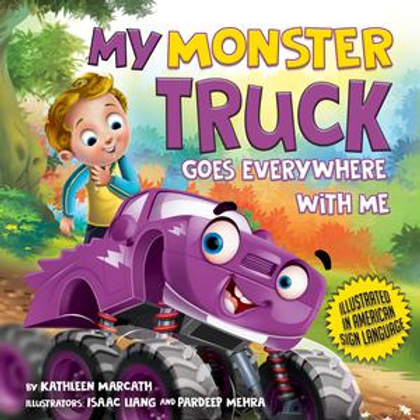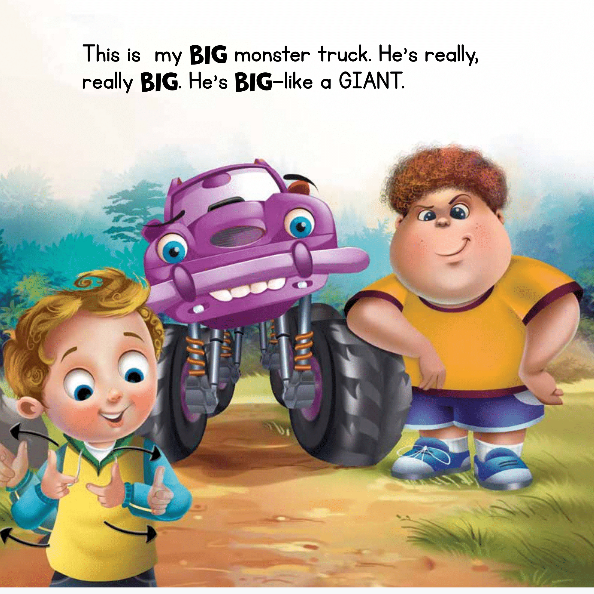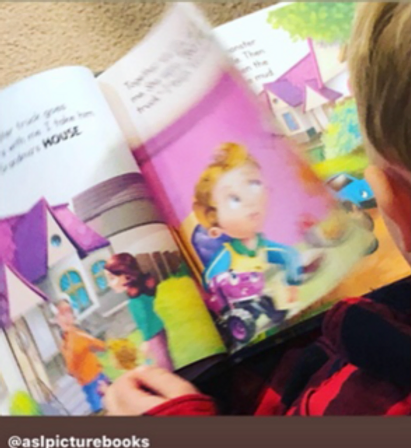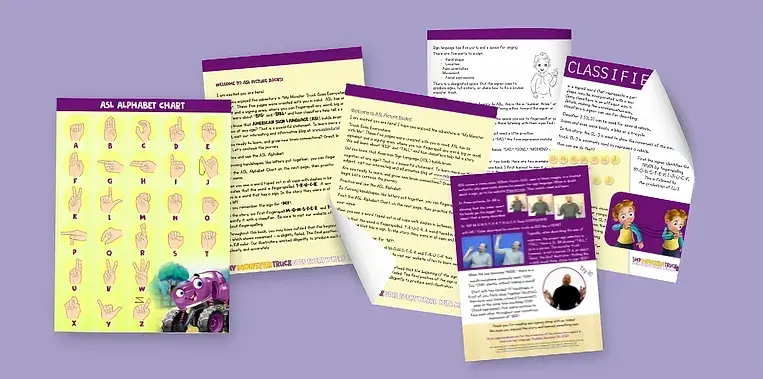Fingerspelling and the Brain: How Repetition Builds Strong Readers
- Kathleen Marcath

- Jul 14
- 6 min read
Did You Know Fingerspelling Can Help Your Child Become a Better Reader?
by Kathleen Marcath
Research shows that orthographic mapping, the brain’s process of connecting letters to words, is strengthened by early fingerspelling, especially in language-rich ASL environments. This boosts letter recognition, vocabulary growth, and reading confidence in both Deaf and hearing children.

What Is Orthographic Mapping?
Orthographic mapping is the mental process that helps children turn letters into words they can recognize by sight. It’s how young readers move from decoding letter-by-letter to instantly recognizing words like “MOM” or “BOOK.”
When we fingerspell words, we support this process in three ways:
Letters (Handshapes): Each letter is a visual shape that teaches children to recognize forms.
Meaning: Fingerspelled words are tied to real concepts — connecting hands to the world.
Memory: With repetition, children store these patterns in long-term memory, much like recognizing a friend’s face.
Research Insight
Deaf parents often begin fingerspelling whole words to their children during infancy, not letter-by-letter. Children of Deaf adults may start fingerspelling as early as 24 months, mimicking the motion and rhythm of entire words. By age four, they begin to identify individual handshapes and connect them to print. This early exposure illustrates how fingerspelling and the brain work together to build foundational language and early literacy skills.
“They spell a word, not individual letters.” — Padden (2006)
Fingerspelling and the Brain: The Power of Repetition
Fingerspelling and the brain work together in powerful ways. As children fingerspell, their brains create lasting visual and motor connections to language.
Each time your child sees or copies a fingerspelled word:
They learn how the letters fit together.
They begin to group blends like C-H, T-H, and endings like -I-N-G, -E-R.
They link the handshapes to real-world meaning.
And they start reading by sight.

When Can My Child Start Fingerspelling?
It is never too early to start. Even toddlers can begin recognizing fingerspelled names and words before they can form perfect handshapes.
Just as hearing babies babble before they speak, Deaf and hard-of-hearing children often imitate signs and fingerspelling—developing their own adorable approximations as they grow toward fluency.
In fact, research shows that children of Deaf adults may begin fingerspelling as early as 24 months. They naturally mimic the rhythm and motion of whole words, even before identifying individual letters. This early exposure strengthens language pathways in the brain and lays the foundation for both ASL fluency and early reading.
Learning Strategies for Parents & Educators
Integrate Familiar Names: Spell out names of family members, pets, or friends to make learning meaningful.
Celebrate Every Attempt: Focus on encouragement, not perfection.
Keep It Fun and Visual: Use games, colorful letters, and interactive books.
ASL Picture Books Favorite Books celebrates excellent stories, inspiring authors, and the beauty of ASL. It’s no surprise our subscribers voted this their favorite page — it reflects the heart of what we’re building: connection, community, and a love for language.

Embracing these strategies can turn fingerspelling into a joyful and empowering experience. Let’s make learning exciting together!
According to ASL educator Christie Homell at the Western Pennsylvania School for the Deaf, early use of fingerspelling lays a foundation for reading and writing success. Frequent exposure helps children develop comfort with the shapes and movements of hands used in ASL, leading to fluency in both ASL and print literacy — a finding supported in the VL2 research brief titled Fingerspelling with Your Toddler!
Featured Book: My Monster Truck Goes Everywhere with Me – Illustrated in ASL
Watch the signs come to life —
Perfect for families learning ASL together!
This award-winning picture book introduces 32 ASL signs through a joyful and familiar story. Repeated words like MONSTER, TRUCK, PURPLE, FAST, and LOUD appear multiple times to support language development through natural repetition.
👉 Bonus: The book includes a QR code linking to videos modeled by Deaf storytellers — ideal for visual learners, anyone learning to sign, and fluent signers.
Help with Sight Words
In kindergarten, children may be expected to recognize 50–200 high-frequency words like “the,” “like,” “come,” and “you.” These words don’t always follow predictable rules, so they’re learned by sight, not sound.
Adding fingerspelling makes the process more engaging, multisensory, and effective, especially for visual learners and DHH children.
Research from Gallaudet University shows that early exposure to fingerspelling supports print awareness, letter recognition, and vocabulary development, especially in language-rich ASL settings.
How Fingerspelling Supports Sight Word Mastery
Fingerspelling turns abstract words into visual, memorable experiences. Here’s how:
🔁 Repetition + Movement = Memory Spell words like Y-O-U or G-O during routines. Children begin recognizing them instantly, like a familiar face.
👋 Visual + Kinesthetic Learning Seeing and signing words activate multiple senses and create strong brain connections.
💛 Emotional Connection Fingerspelling during story time or everyday moments builds associations with joy, comfort, and success.
Free Download: ASL Starter Kit
🖐️ Perfect for preschoolers and early readers! Includes:
An illustrated ASL fingerspelling alphabet chart
Signing basics
Fingerspelling tips
Using a classifier
How BIG is BIG
A sample of coloring and activity pages
👉 Click here to download and build your fingerspelling routine today!
Keep Signing, Keep Smiling
Every time you fingerspell a word, you’re doing more than teaching letters — you’re creating a lifelong love for language, literacy, and connection. By embracing fingerspelling at home or in the classroom, you’re actively supporting how fingerspelling and the brain work together to reinforce reading success.
What’s your child’s favorite word to fingerspell?
We’d love to hear about it — tag us or reply to share your story!
Every letter you fingerspell builds a bridge to lifelong literacy and joy.
Want More Early ASL Learning Tips?
Join our ASL Family!👉 Sign up here and get free resources, literacy printables, and fun ASL tips delivered straight to your inbox.

References
Homell, C. (2023). Fingerspelling with your toddler! In Visual Language and Visual Learning (VL2) Research Briefs. Gallaudet University. Retrieved from VL2 Brief
Humphries, T., et al. (2014). Visual Language and Visual Learning (VL2) Research Brief #5: Fingerspelling and Early Literacy. Gallaudet University.
Morere, D., & Allen, T. (2012). Early Education Longitudinal Study: Literacy Achievement in Deaf Children.
Padden, C. (2006). Learning to Fingerspell Twice: Young Signing Children’s Acquisition of Fingerspelling. In B. Schick, M. Marschark, & P. Spencer (Eds.), Advances in the Sign Language Development of Deaf Children (pp. 189–201). Oxford University Press.
Padden, C., & Hanson, V. (2000). Fingerspelling and Reading: From Fingerspelling to Lexicalized Signs. In M. Marschark & P. E. Spencer (Eds.), The Oxford Handbook of Deaf Studies, Language, and Education.
Quinto-Pozos, D., & Reynolds, W. (2012). ASL Input and Deaf Children’s Development of Fingerspelling. Sign Language Studies, 12(4), 539–564.
Keep the Journey Going
We hope you enjoyed this story and feel inspired to keep signing with the children in your life. You’re doing an amazing job opening a world of communication for them! Before you go, here are some ways to continue your ASL adventure:
Read Next: Dive into another inspiring post on our blog to keep learning and celebrating Deaf culture.
Author Visits: Book an author visit to bring the magic of ASL to your school or library and inspire your community.
Freebie: Get your free printable ASL Alphabet Chart in the ASL Starter Kit to practice with your little ones – a fun resource to hang on the fridge or classroom wall.
Join Our Community: Sign up for our newsletter to receive tips, free resources, and uplifting stories straight to your inbox.
Meet the Author: Kathleen Marcath

Kathleen Marcath is the award-winning author of My Monster Truck Goes Everywhere with Me and the founder of ASL Picture Books. She’s on a mission to share the joy of bilingual (ASL and English) education, creating stories that help children and families discover the limitless potential of ASL.
Stay in Touch: Follow Kathleen on Facebook and Instagram, or visit ASLPictureBooks.com for more resources and community updates.
.jpg)







Comments